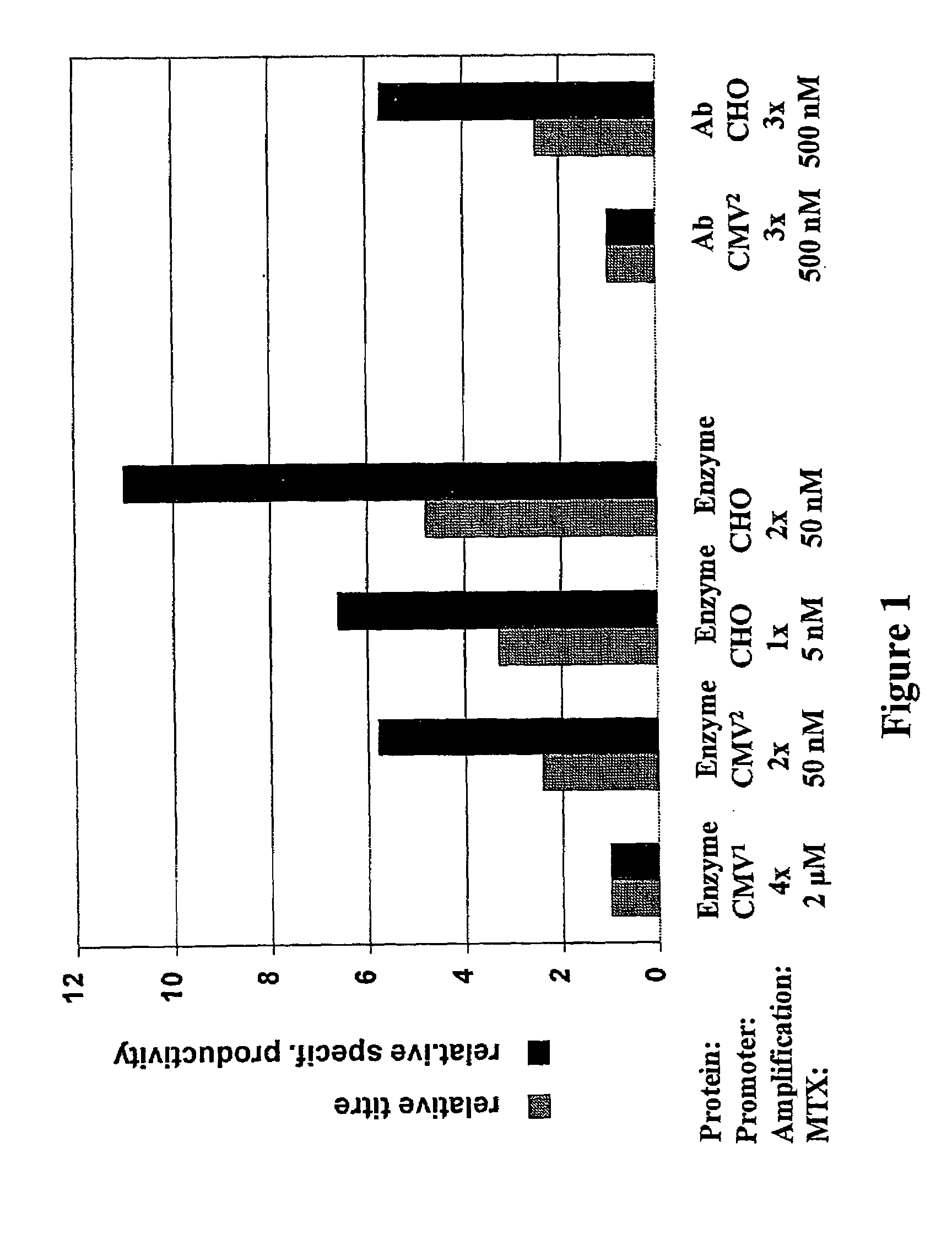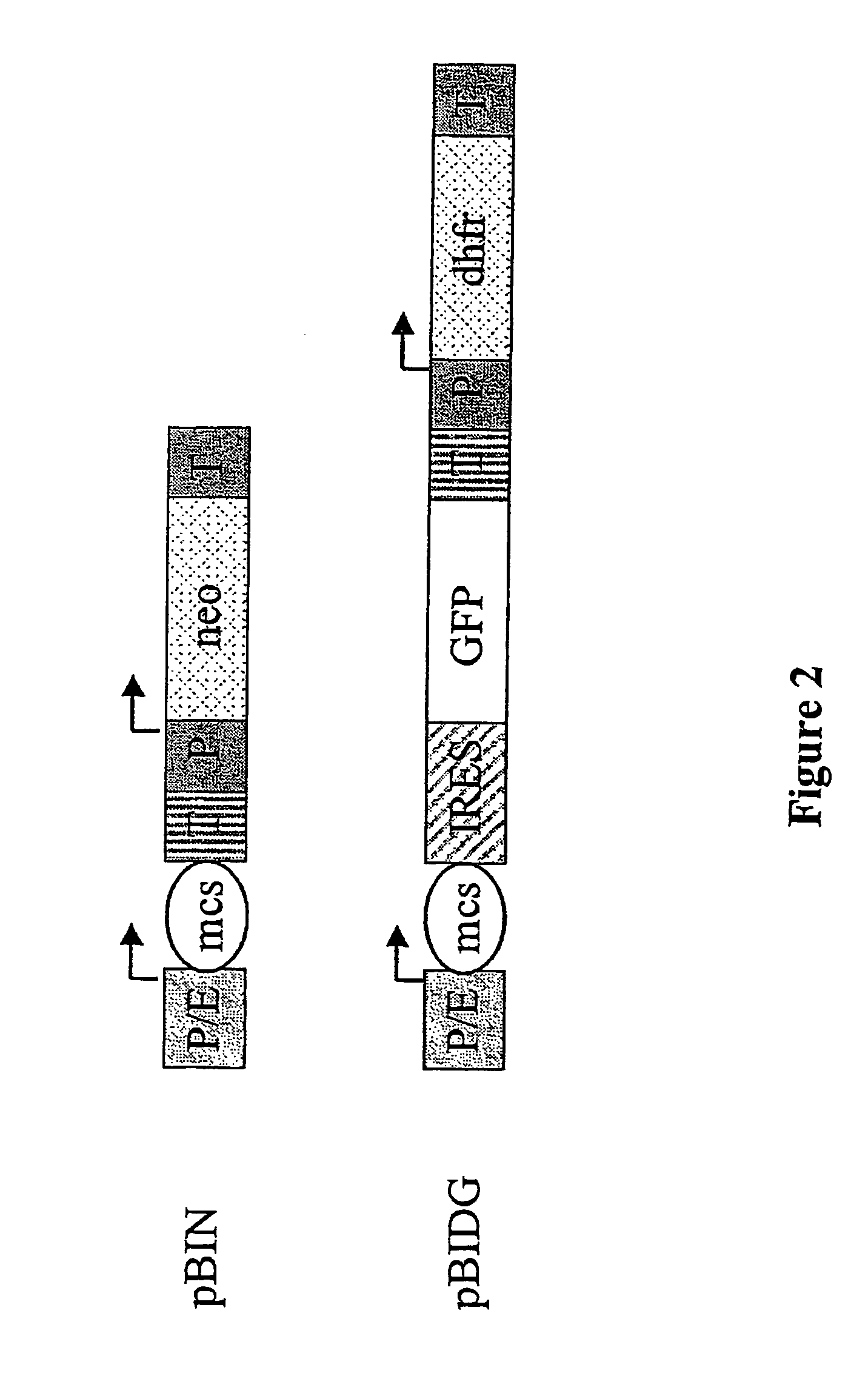Expression vector, methods for the production of heterologous gene products and for the selection of recombinant cells producing high levels of such products
a technology of expression vectors and products, applied in the field of expression vectors, can solve the problems of high labor intensity and time consumption, high labor intensity and cost, and high labor intensity of selection steps, and achieve the effects of high expression rates, good correlation, and short tim
- Summary
- Abstract
- Description
- Claims
- Application Information
AI Technical Summary
Benefits of technology
Problems solved by technology
Method used
Image
Examples
example 1
Comparison of the CMV and Hamster-ubiquitin / S27a-Promoter Activity
[0144]In order to compare the activity of the hamster-ubiquitin / S27a-promoters with that of the CMV promoter frequently used in eukaryotic expression vectors, CHO-DG44 cells were transfected with various recombinant vectors. The heterologous gene product, on the one hand a lysosomal enzyme, on the other hand an IgG1-antibody, was expressed either under the control of the CMV-promoter or under the control of the hamster-ubiquitin / S27a-promoter. The two promoters were functionally linked to the CMV-enhancer. BGH polyA was used as the termination signal for the heterologous gene. The expression vectors which contained the CMV-promoter were based either on a modified pcDNA3 (“CMV1”, Invitrogen) or pBluescript vector (“CMV2”, Stratagene) and additionally coded for the amplifiable selectable marker dihydrofolate-reductase. The expression vector with the hamster promoter on the other had was based on the pAD-CVM vector (Wern...
example 2
Isolation of High-expressing sICAM Cells by GFP-based FACS Sorting
[0147]The soluble form of the intercellular adhesion molecule ICAM1, sICAM, is a possible treatment for colds as it competes with the ICAM receptor for the binding of rhinoviruses and in this way can reduce or even prevent their interaction with the ICAM receptor, the prerequisite for entry into the cells and subsequent infection (Bella, J. et al., J. Struct. Biol. 1999,128, 69-74; Marlin, S. D. et al., Nature 1990, 344, 70-77).
[0148]sICAM was chosen as an example for the expression of a single-chained protein (480 amino acids) in CHO cells. For this CHO-DG44 were transfected with pBIDG-sICAM (FIG. 3). The additional expression of GFP in pBIDG-sICAM transfected cells made it possible to use a FACS-based selection strategy. The therapeutic protein sICAM and GFP were jointly expressed by a bicistronic transcription unit and the DHFR by a separate transcription unit. Two to three weeks after the first selection in HT-fre...
example 3
Isolation of Cells With High Expression of the mAb F19 by GFP-based FACS Sorting
[0149]In a co-transfection CHO-DG44 cells were transfected with the plasmid combination pBIDG-F19HC and pBIN-F19LC (FIG. 3). The expressed humanised antibody F19 is directed against the surface molecule FAP which is synthesized by reactive stroma fibroblasts (cf also EP 0 953 639). In the vector configurations used the two protein chains of the antibody are expressed by their own vector, which additionally also codes for a DHFR or neomycin-phosphotransferase selectable marker in a separate transcription unit. In addition, another selectable marker, GFP, is contained in the vector pBIDG-F19HC. By the transcriptional linking of the expression of the GFP and the heavy chain by means of an IRES element, in the co-transfection of CHO-DG44 with the vectors pBIDG-F19HC / pBIN-F19LC, cells with a high expression of the antibody F19 could rapidly be isolated solely by selecting the cells with a high GFP content usi...
PUM
| Property | Measurement | Unit |
|---|---|---|
| length of time | aaaaa | aaaaa |
| volume | aaaaa | aaaaa |
| volume | aaaaa | aaaaa |
Abstract
Description
Claims
Application Information
 Login to View More
Login to View More - R&D
- Intellectual Property
- Life Sciences
- Materials
- Tech Scout
- Unparalleled Data Quality
- Higher Quality Content
- 60% Fewer Hallucinations
Browse by: Latest US Patents, China's latest patents, Technical Efficacy Thesaurus, Application Domain, Technology Topic, Popular Technical Reports.
© 2025 PatSnap. All rights reserved.Legal|Privacy policy|Modern Slavery Act Transparency Statement|Sitemap|About US| Contact US: help@patsnap.com



